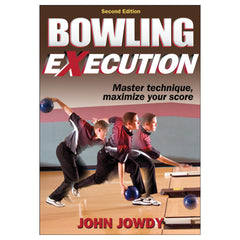Power Player's Approach
This is an excerpt from Bowling eXecution-2nd Edition by John Jowdy.
The textbook version of a four-step approach is this: Walk three steps in a straight line, then slide directly in line with the preceding step. This approach has become a rarity for many players in an era of explosive bowling balls. Today we see more and more bowlers drifting 10 to 20 boards leftward (for right-handers). These power players possess incredible hook balls that cover a path crossing 15 to 20 boards and enter the pocket at extreme angles; these bowlers rely on modern balls to increase their strike percentage.
Power players' system of execution is diametrically opposed to that of textbook bowlers. Power players push the ball to the left of their bodies, walk away from the swing, and open their shoulders in the last two steps. They slide anywhere from the 35th to the 40th board, lay the ball down somewhere between the 28th and 33rd board, cross between the 5th and 6th arrow, and send the ball to an area between the 5th and 10th board at the breakpoint. (All points depend on the condition of lane dressing.)
Brian Himmler, Brian Kretzer, and Robert Smith stand out among those who walk extremely leftward. When lanes permit them to open up, they open their shoulders and unleash explosive strike balls. Himmler's five-step approach features a unique, quick-skipping fourth step that triggers an extraordinarily high backswing and leads into an extended follow-through from the shoulder joint (depicted by Tommy Jones in figure 4.5).
Pete Weber, arguably the greatest talent in the game today, uses a five-step approach. He uses an extremely high backswing that he developed as a young bowler; small in stature, he was compelled to add height to his backswing to gain additional speed. He maintained this style and incorporated a smooth five-step approach with a clean, pure release. Weber drifts leftward and opens up the lanes, but, unlike other power players, Pete succeeds with unusually slow ball speed.
Power balls are exciting and impressive, and power players can be dominant on conditions that permit wide-hooking balls to carom off the breakpoints and drive into the pocket with incredible force. Opening up the lanes does not require pinpoint accuracy but rather affords power bowlers the luxury of playing an area rather than a certain board on the lanes. This is not, in any manner, meant as an indictment of power players. Many PBA players have managed to successfully harness their power under demanding conditions. Power bowlers such as Jason Couch, Amleto Monacelli, and Pete Weber have exhibited their all-around talents, winning championships in any and every lane condition.
Yet the bowling game is full of players-pro and amateur-who unleash dynamic strike balls yet have little to show for it. Timing and accuracy are far bigger advantages to bowlers than are high-powered missiles that lack the consistency for overall scoring. In many cases, a bowler's inability to compete at the highest level can be traced to a lack of proper footwork, timing, or release point.
Although many bowlers drift leftward intentionally, others have developed an unwitting tendency to move left. Several methods can be used to correct a drift. One is the age-old exercise of rehearsing a foot pattern on the lanes without a ball. Another is to place tape on the lanes in a desired line and repeatedly retrace the line with eyes glued to the tape. Repeat the procedure until it becomes routine.
Proper footwork is important in addressing spares, particularly for power players. While opening up the lanes on strike shots is a power player's forte, it is important in converting a spare to position the body and feet correctly. In trying to convert one-, two-, and three-pin spares, it is much better to focus on straighter shots, accuracy, and proper footwork than on drifting left, opening the shoulders, and delivering high-revolving balls. Always remember that accuracy and proper footwork simplify the game.
Excerpt from Bowling eXecution 2E.
More Excerpts From Bowling eXecution-2nd Edition


Get the latest insights with regular newsletters, plus periodic product information and special insider offers.
JOIN NOW
Latest Posts
- What performance obstacles do master athletes face?
- Cannabidiol (CBD) and mycoprotein as supplements
- Weight, body composition, and performance in athletes
- The gut-brain-bone axis and Biodynamic Skeletal Therapy
- Touch-testing in Biodynamic Skeletal Therapy treatment
- The six stages of Biodynamic Skeletal Therapy treatment


